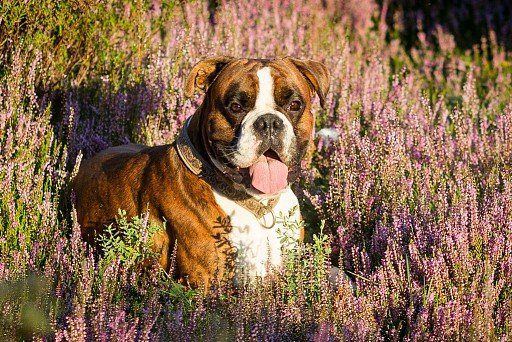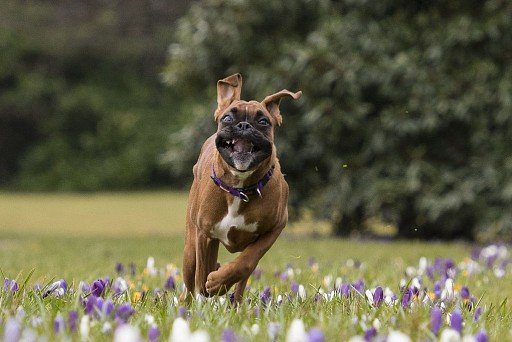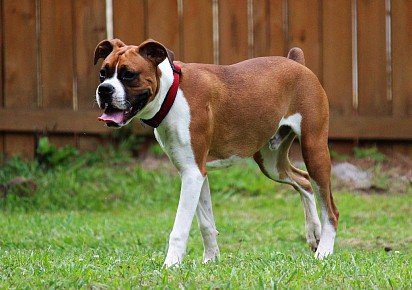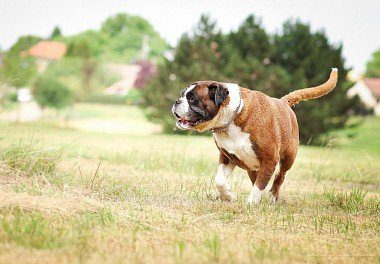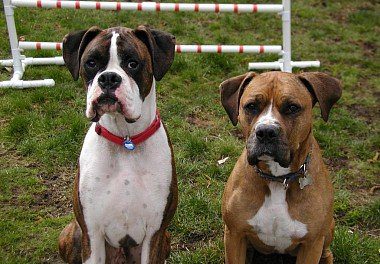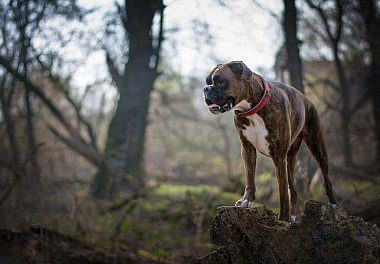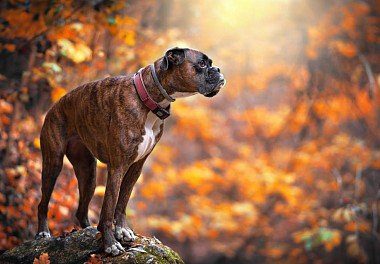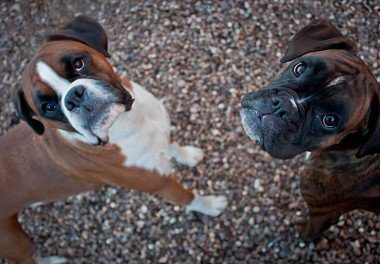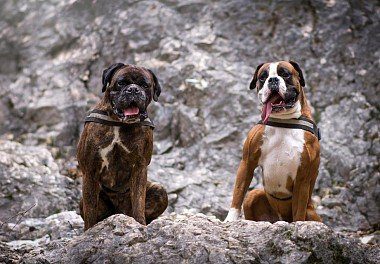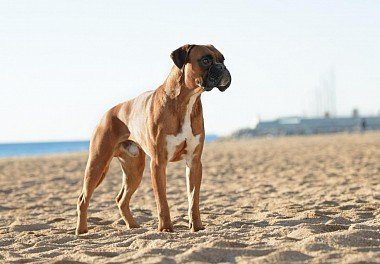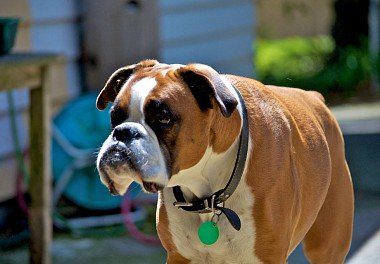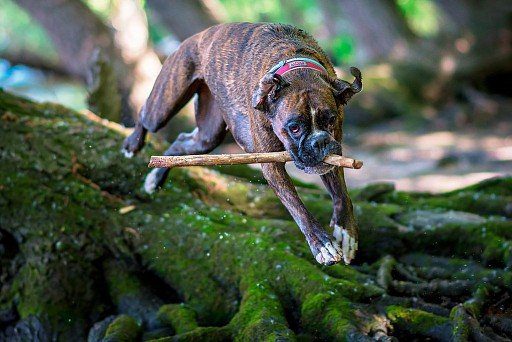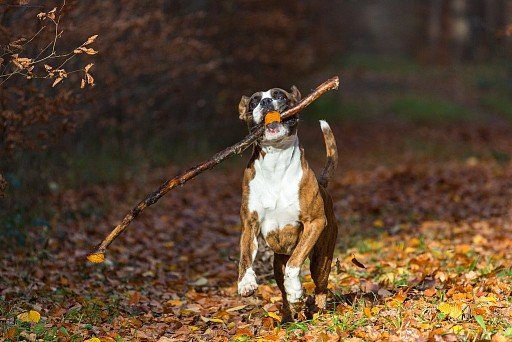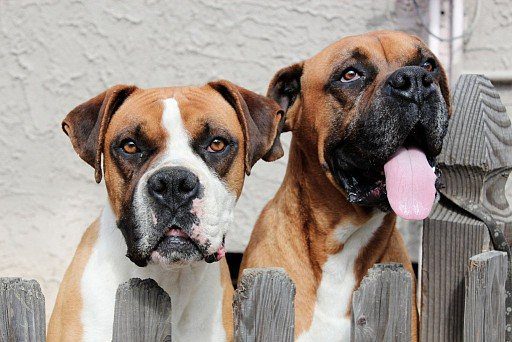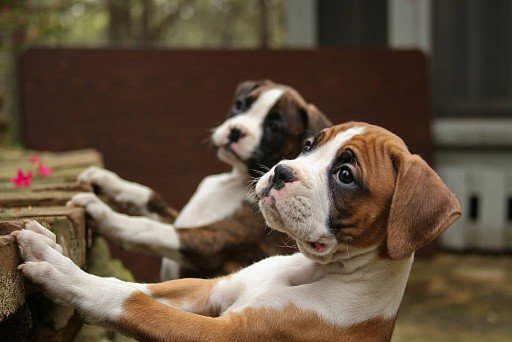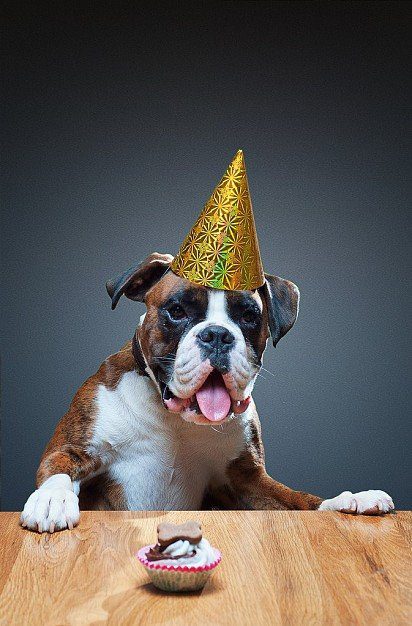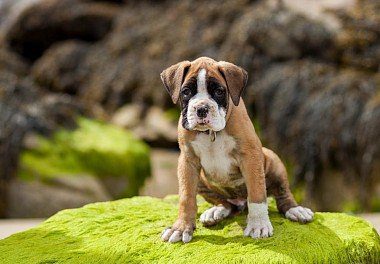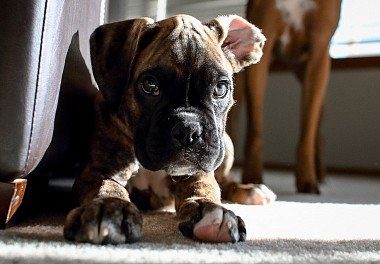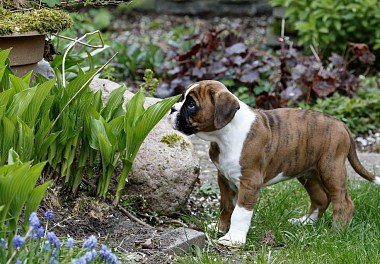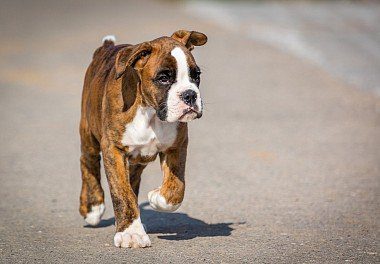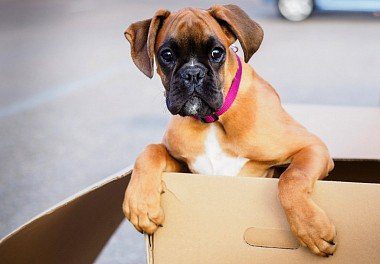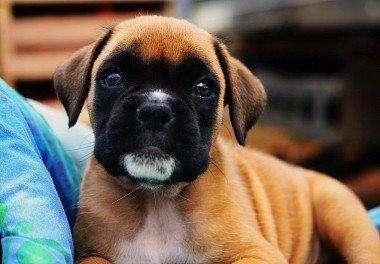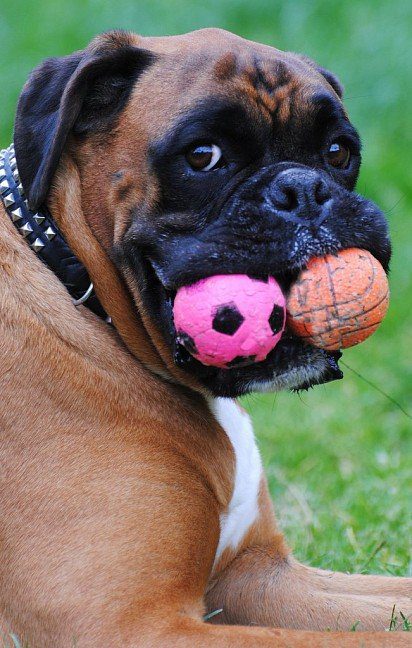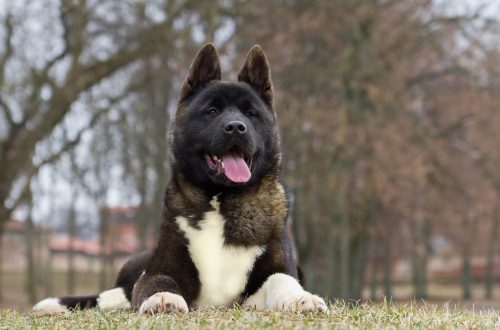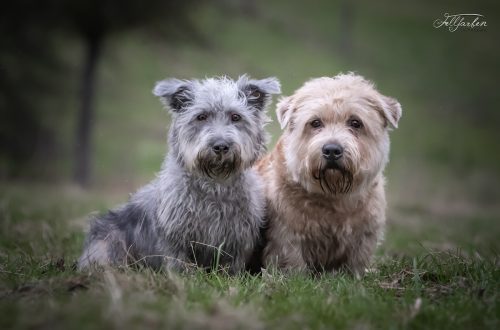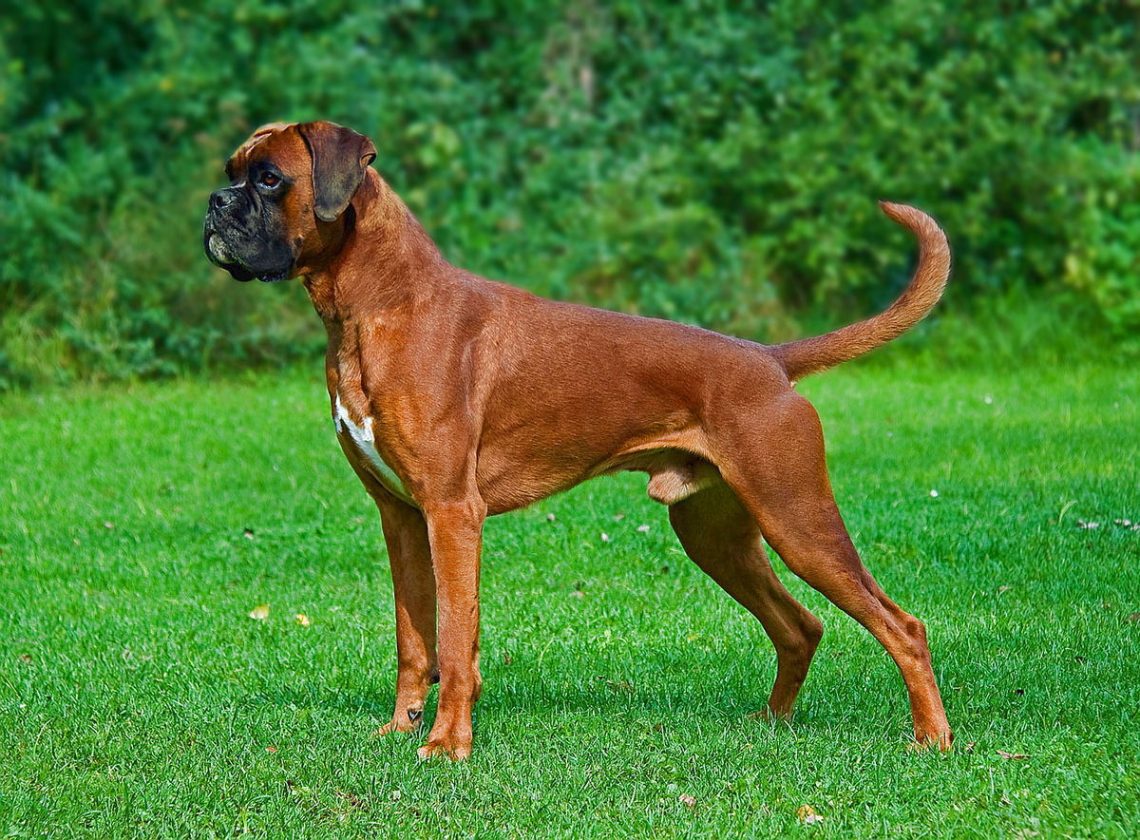
Boxer
Other names: German boxer
The German Boxer, or simply Boxer, is a large, stocky, smooth-haired breed. Bred in Germany, it has gained wide popularity due to its excellent protective qualities. The boxer becomes a wonderful companion and true friend for his master.
Contents
- short information
- Basic moments
- History of the boxer breed
- Video: German boxer
- Features of the German boxer
- Appearance and special features of the breed
- Photo of an adult boxer
- Boxer character
- Training and education
- Care and maintenance
- Boxer health and disease
- How to choose a puppy
- Photo of boxer puppies
- How much does a boxer cost
short information
- Breed name: Boxer
- Country of origin: Germany
- Time of origin of the breed: 1850
- Weight: males ~30 kg, females ~25 kg
- Height (height at the withers): males 57-63 cm, females 53-59 cm
- Lifespan: 11-12 years
Basic moments
- A bright temperament and at the same time an agreeable character and a strong nervous system – these features are most fully expressed in German boxers.
- Boxer is an excellent watchman, and all thanks to his courage and fearlessness.
- Dogs of this breed in the family circle are very sociable, they love it when the owners are attentive to them, they show friendliness to all household members.
- Affectionate boxer is a real find for families with small children. He will play with them with pleasure, and then willingly lie down on the sofa (including with adults) to relax together.
- Boxers often treat strangers with distrust: when guests appear in the house, they begin to bark loudly. Socialization of the animal from an early age will help in solving this problem.
- Proper upbringing of a boxer is a guarantee that a faithful and devoted friend will grow out of a puppy.
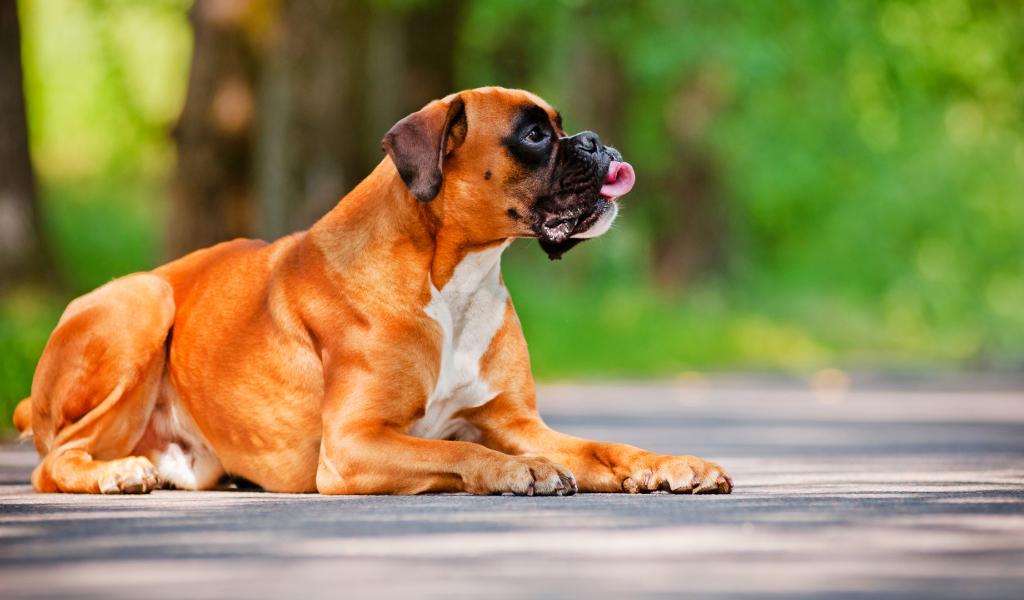
German boxers are used as bodyguard dogs, as watchdogs and for law enforcement work. Representatives of this breed are smart and balanced, which allows them to be used as guides for the blind. The boxer dog is very mobile by nature, loves to be in the fresh air, walk for a long time, frolic in the open air. Despite the sociability and friendliness towards the owner and family members, she has a cautious attitude towards strangers, shows wariness towards them.
History of the boxer breed
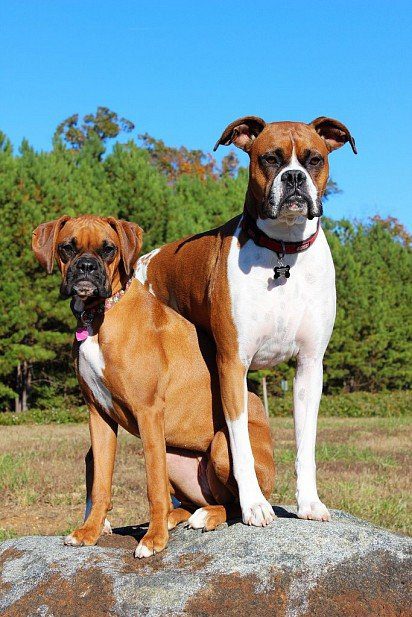
The ancestors of the German boxer are bulldogs, mastiffs and bullenbeisers. It was due to the mixing of their blood that this breed was born, which began to conquer the world since 1896.
Boxers of the late 19th century and modern boxers are not quite the same thing. In those distant years, they were used as shepherds, for transporting goods and hunting for wild boars and bison. Often the early representatives of the breed became participants in dog fights and even fights with bulls. During the First World War, the German army successfully used them as postmen and scouts. At the same time, German boxers also showed themselves as guide dogs. Later, dogs of this breed also revealed their “creative” talents, successfully performing in circus and theatrical performances.
An interesting version of the earlier origin of boxers. Some researchers argue that their direct ancestors are the Tibetan Great Danes, who ended up in Rome and Greece in ancient times. It is believed that ancient boxers were larger and more aggressive. Their inherent bloodthirstiness helped them cope with the tasks of a military nature. They were used for protection and as a pickling dog during hunting for large forest game, as well as in the popular entertainments of those times – dog fights, which were practically not inferior to gladiatorial ones in terms of intensity of passions.
Since the end of the century before last, the German boxer began to conquer the world, he had many fans in different parts of the world, even opening clubs dedicated to this incredibly stately, portly and beautiful dog. Her appearance seems aggressive (sometimes it may seem that she is ready to rush at a stranger and tear him apart), but behind her are good nature and an accommodating character. This is a great merit of breeders who have done everything possible to add such traits as kindness and balance to dexterity, endurance and speed of reaction.
When a dog wants to play, it begins to touch in the air with its paws, as if boxing. Such a special manner, which makes it unlike other dogs, predetermined the name of the breed. According to the owners, boxers have all the necessary qualities for living in a family, so they are the best!
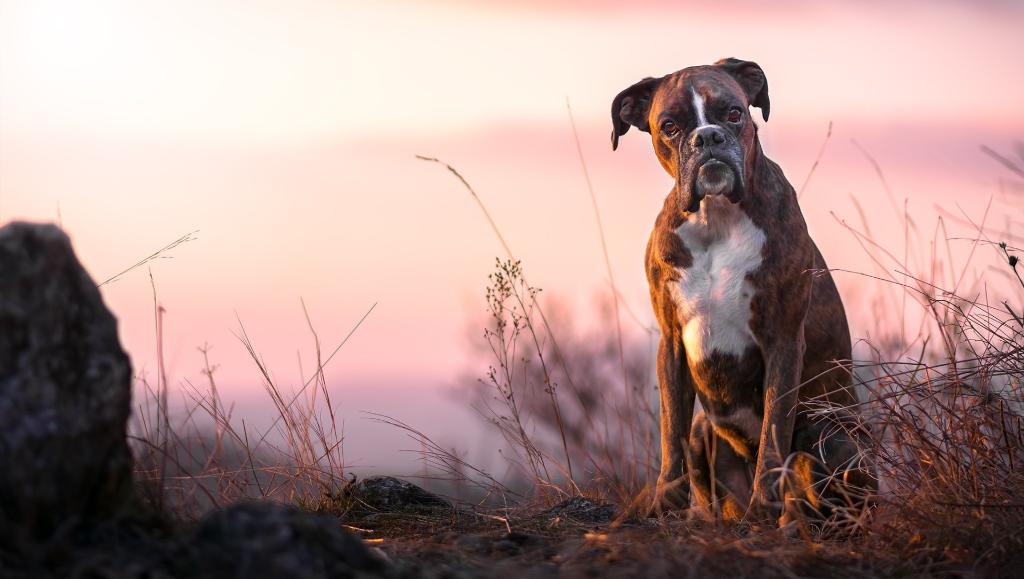
Video: German boxer
Features of the German boxer
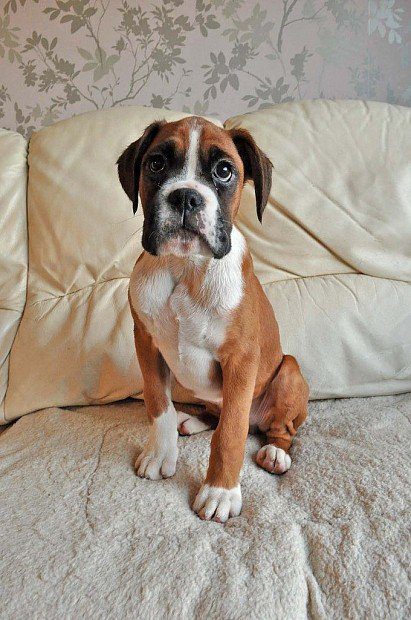
A German boxer at the age of 18 months is already an adult dog, fully formed physically. However, by the age of one and a half, the inner world is still “childish”. For this reason, attempts to train a dog during the period of his emotional immaturity are practically hopeless, that is, he does not respond to commands, the owner even begins to think that he is communicating with the deaf. But at one fine moment, a breakthrough comes in learning, and your pet suddenly begins to understand everything that they tried to teach him before, but in vain.
The Boxer is a sociable dog, it gets along easily with other four-legged inhabitants of the house, but sometimes the cockiness in character takes over and it starts to chase the yard cats. It happens that a dog of this breed easily gets into a fight with other dogs, and he often provokes fights himself. By nature, a boxer is a real fighter, he is dexterous, brave and strong. If it is properly trained, then you can bring up an excellent guard. The childish spontaneity inherent in a boxer remains with him all his life. The dog shows enviable stubbornness, but never achieves its goal with aggression. His main weapon is humor and charm, which no loving owner can resist.
Representatives of this breed have amazing sensitivity, they are very smart and cunning. Sometimes they are noisy, which is perceived by some owners as a disadvantage, therefore, in order to develop the best character traits and minimize shortcomings, it is necessary to train boxers. With the right approach to this task, you can achieve amazing results, as boxers perceive training as a game and easily succumb to it.
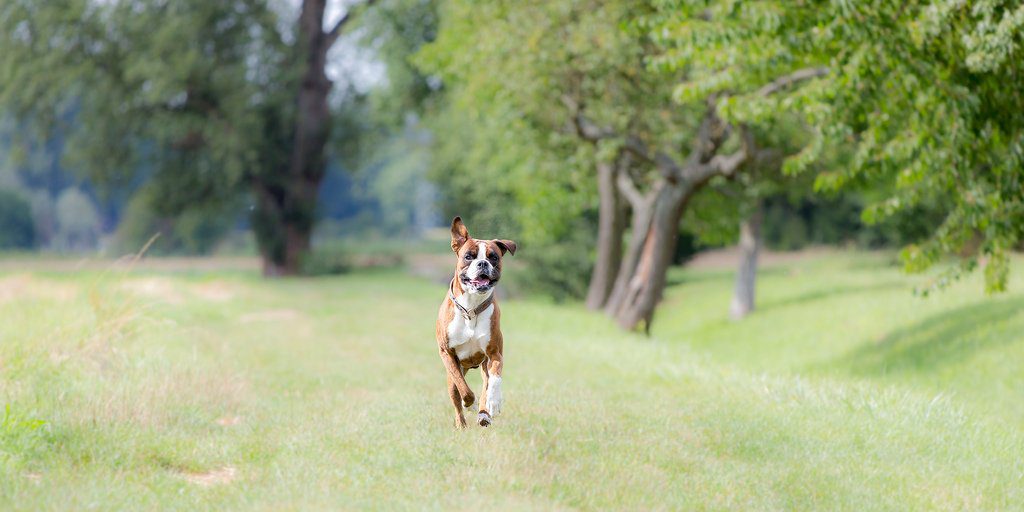
Appearance and special features of the breed
Boxers have a stocky build. They are also called “square” dogs, since their height and length are approximately the same. A wide and deep chest, coupled with a strong back with a slight slope in the pelvic region, is quite consistent with this type of physique. However, representatives of this breed do not look squat – rather the opposite. Dogs look stately, they have a proud posture, and all thanks to dry muscles and a lean stomach. Their limbs are massive, correctly set, without curvature, so they do not spoil the “figure”. The neck of the boxer is of medium length, strong and muscular, and the tail is long and even.
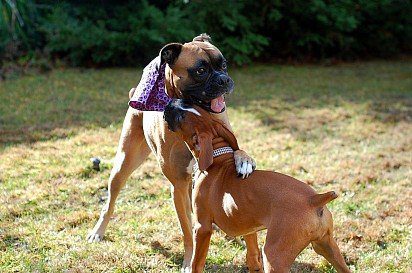
A distinctive feature of the breed is a slightly protruding lower jaw, a slightly upturned nose and high-set ears – thin, slightly hanging forward. When circumcised (cupped), they acquire a pointed shape, which gives them the correct setting. Boxer’s eyes are dark, intelligent, they can tell a lot about the breed. Curiosity can be read in the look, it glows with energy, but not aggression.
The skin of boxers, with the exception of the forehead and cheeks, fits snugly and does not form any folds. Wool – short, hard – also fits snugly. Only two colors are considered classic for German boxers: red and brindle. The first can vary from rich red to light yellow shades. Brindle has its own “extremes”: from golden to dark dark. The breed standard suggests that the stripes should be in the form of clear lines.
Whatever the color, a kind of dark mask is an invariable attribute on the dog’s face. The presence of white markings is acceptable, giving the breed aesthetics. “Defective” are white, black, gray dogs with a lot of stripes and spots. And one more thing: if you plan to send your pet to the exhibition, then cropping of the ears and tail will have to be sacrificed. Specialists categorically do not recommend carrying out such manipulations with a boxer.
General description
- The height of the German boxer is average, about 60 cm at the withers. An adult dog weighs from 25 to 32 kg.
- Dogs of this breed have superbly developed and voluminous muscles. Their movements are active, energetic, filled with nobility and strength.
- Boxers, despite the “square” physique, have sufficient substance. That is, you cannot call them clumsy, heavy or, conversely, too light.
- They are characterized by balance, they often serve as guides for blind people.
- Males are larger than females. Pedigree parents can have up to 7 puppies in one litter.
Head
The head corresponds to the proportions of the body and, giving the dog a special identity, does not look too massive or too light. Muzzle, ideally, as wide and powerful as possible. The correct ratio of the skull and muzzle provides the boxer with the harmony of his head. No matter where you look – front, side or top – the muzzle in relation to the skull remains in the right proportion and does not look too small.
The boxer’s head is dry, there are no folds or wrinkles on it. The latter are formed, and this is allowed, only in cases where the dog is alerted by something. On the muzzle, on both sides, there are natural wrinkles. But not everywhere, but only in the area from the base of the bridge of the nose down. Against the general background of the muzzle, a black mask is clearly visible. Despite the gloomy shade, it does not at all add gloom to the appearance of the dog.
The upper region of the skull is not wide, not flat and extremely angular. Its shape is somewhat convex, but not shortened or spherical. The severity of the tubercle in the occipital region is not excessive. The furrow on the forehead (primarily the area between the eyes) does not differ in depth and is only slightly visible. The area from the forehead to the back of the nose has a ledge, which is clearly visible. The back of the nose is not lowered and, unlike the bulldogs, is not upturned.

Teeth
The lower jaw, if compared with the upper jaw, is slightly longer. Its distinguishing feature is its curvature upwards. The base of the upper jaw is wide, tapering towards the end. Boxer’s teeth are distinguished by excellent health, very strong. The fangs are impressive in size, widely spaced. The incisors are located on the same line, very evenly. The form of the dog’s bite is undershot.
Eyes
The eyes of Boxers are rather big, dark in color, not deep set and do not differ in bulge. The edges of the eyelids are also dark. Dogs look intelligent and energetic at the same time, their look is kind and does not carry any threat.
Ears
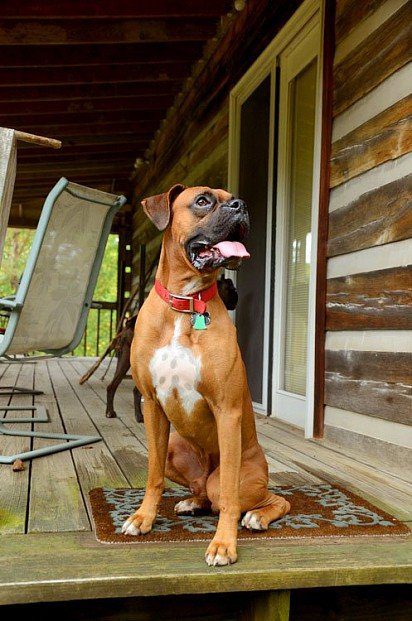
They are located on the sides in the upper region of the skull, their landing is high, the size is proportional. In a state where nothing bothers the dog, and there is no need to listen to sounds, they are adjacent to the cheekbones. If your pet is alert, then the ears will immediately turn forward, forming a clear inflection.
Nose and lips
Thanks to the nose, the muzzle of the dog has a complete look, its tip is slightly higher than the base. The lobe is slightly upturned, it is wide, the color is black, the nostrils are also wide.
The upper lip is pronounced, fleshy. It closes the free area formed due to the fact that the lower jaw is longer. The lower fangs support the upper lip.
Neck
The boxer’s neck is lean, muscular and at the same time rounded and long (but not excessively). From the mound at the back of the head in the direction of the withers, the upper border of the neck forms a graceful arc.
Frame
The boxer’s withers are pronounced, strong, developed limbs serve as a support for the body. The back is wide, with a “pumped up” muscular system, but short and even. The croup is somewhat rounded, wide, slightly sloping. The pelvis, first of all, this applies to females, wide and long.
The chest area is so deep that it reaches down to the elbows and is equal to half the height of the dog at the withers. Its front part is powerful, superbly developed.
The underline has an elegant curve towards the ischial tuberosity. The groin cannot boast of length, moderately tucked up.
Tail
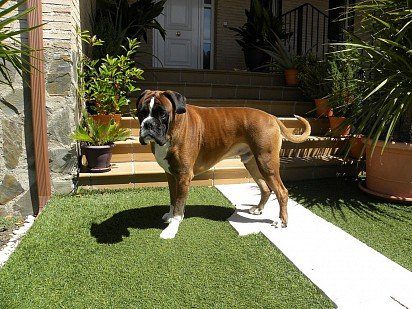
It has a fairly high seating position. Usually it is not stopped, that is, it is left unchanged – the way it is by nature.
limbs
If you stand in front of the dog, you can see that the front legs are parallel to each other. The bones of the limbs are strong.
The blades are firmly connected to the body, differ in length and have a slope. The shoulders are also long, located at the right angle relative to the shoulder blades. The elbows are pressed to the chest not too tightly.
The forearms are also by no means short, located vertically, muscular. Pasterns, on the contrary, are short, almost vertical. The wrists are clearly marked: they are strong, but not too massive.
The forelegs are rounded, small, compact, with firm and elastic pads. The hind legs are naturally well “pumped up”, straight, the hips are pronouncedly wide and long.
The hind legs are slightly longer than the front ones. They are also compact, the pads are firm and resilient.
When a boxer is calm, his knee joints move forward so clearly that they even reach a conditional perpendicular outlined in the direction of the surface from the iliac tubercles.
Muscularity is inherent in the legs. The hocks, although not massive, are strong and well defined.
Wool
The hair adheres tightly to the skin, it is short and hard, it glistens.
Color
Boxers come in red or brindle. Any shades of the first are allowed, ranging from light yellow to red-brown. The most typical of the breed, or, in other words, the preferred are reddish-brown tones.
Brindle color has the appearance of dark or black stripes on a red background. They should be clearly defined and contrast with the background. White areas are not forbidden and, accordingly, they are not considered a “marriage” of the breed – on the contrary, they can even decorate a dog.
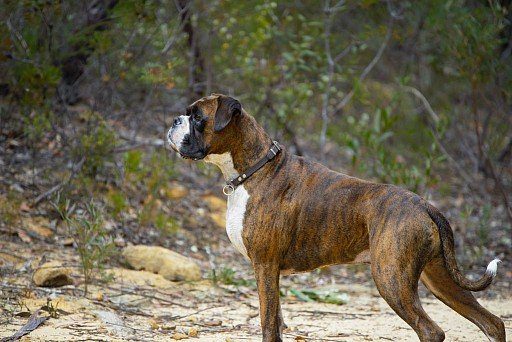
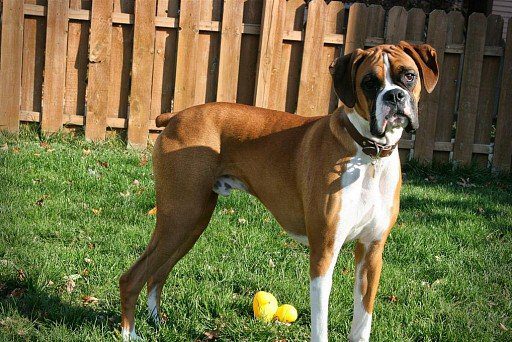
Possible vices
Various variations that do not meet the breed standards listed above are considered faults. The evaluation of these deficiencies should be carried out according to their severity, as well as how they affect the daily lifestyle of the dog and its health.
Disqualifying vices
The White Boxer is considered rare and can cost more than dogs that meet the breed standard.
Physical: congenital bobtail. Behavioral: cowardice or, conversely, aggressiveness.
Testicular defects: in healthy males, they should be normally developed, fully descended into the scrotum.
Any representative of the breed showing obvious physical defects or abnormal behavior must be disqualified.
Lifespan
The German boxer lives on average 11-12 years. There are happy exceptions to this rule.
Photo of an adult boxer
Boxer character
Cheerful, playful, curious, cheerful, energetic – these features fully characterize German boxers. And these dogs are also loyal, very strongly attached to their owner and members of his family. Positive traits remain with the boxer all his life, he likes when there are a lot of people and noise around.
A boxer who has gone through a good training school gets along well with small family members, treats them with care, never offends and plays with them with pleasure. He will not only become an excellent companion for your child, but also a reliable guard.
A representative of this breed, subject to good upbringing and social adaptation, will get along well not only with other dogs living in the house, but even with cats. However, the real “temptation” for them are small animals and birds. You can teach your pet not to touch them, and he won’t do it in front of you. But, as they say, it’s better not to leave the boxer alone with them.
The boxer loves to fool around, cordially greet all the people he knows. He never loses vigilance, and therefore he will be a good protector for his household. This brave, athletic breed sometimes retains excellent security and guard qualities until old age. In order for the dog not to show its not the best qualities – excessive noise, stubbornness, and sometimes uncontrollability – he needs an owner who will dominate him.
Adults have a calm temperament, which is a direct result of proper training at an early age. The popularity of the breed is precisely due to this very balance, coupled with a natural mind and tolerance for people and other pets. In relation to his master, the boxer shows the most tender feelings and shows with all his appearance that he really likes to be around. If you do not cultivate communicative qualities in him, the dog will show suspicion of strangers all his life, bark at them, refuse to let them near the owner.
The boxer retains children’s activity and spontaneity until the age of 2-3, although in physical terms he matures by the age of one and a half. Many owners, who are not aware of the intricacies of the breed, complain that the boxer does not understand the commands that he is taught. In fact, the dog needs time to learn and consolidate new information. The owners are then convinced that this is so: at one fine moment, the dog begins to do everything that he, it would seem, was taught to no avail for a long time.
Training and education
Boxers are intelligent and well trained dogs. At the same time, they are stubborn and perceive new information selectively. They refuse to carry out many commands, preferring to obey only those that they like.
Some owners believe that it is necessary to train a representative of this breed using the “carrot and stick” method, that is, punishing disobedience and encouraging the exact execution of commands. However, the “whip” in this technique will be superfluous, since boxers react badly to punishment. Various rewards (praise, treats, rewards) make them more receptive to training. Using a certain set of commands, in the process of training, you are sure to achieve excellent results. With the correct and intelligible setting of tasks, the boxer remembers the learned commands for a long time.
The education of a boxer usually begins from the moment the puppy is in the house, and full-fledged training starts from the age of three months. First of all, the dog is taught basic commands, such as “Sit!”, “Lie down!”, “Next!”. When your pet learns them, you can start learning the command “Come to me!”. This command is considered the main one, the boxer must perform it in any situation and from the first time.
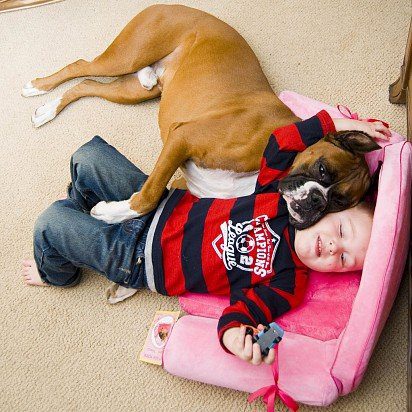
Boxer is very fond of expanse, so the countryside suits him perfectly. But even in the apartment, your four-legged friend will feel good if you regularly take him for walks in a large park, where he can walk for a long time. The dog will become an excellent companion for the owner who loves morning or evening jogging. He is ready to spend the whole day outdoors.
Dogs of this breed are often left to frolic in the courtyards of houses, before making sure that the fence is strong. The latter is useful: there are many cases when German boxers jumped over the fence and ran away. Their jaws are so powerful that, left alone at home, they can even bite the lock on the door.
Care and maintenance
Wherever you settle your pet, in an apartment or a country house, he will perfectly take root everywhere. He will be comfortable even in an ordinary kennel, but on condition that another dog shares this “living space” with him.
In general, German boxers are quite unpretentious in care, but they do not tolerate cold and high humidity.
Since the boxer’s coat is short, unlike long-haired breeds, it does not get tangled or tangled, and therefore does not need frequent combing.
Bathing boxers is often not recommended. If your pet gets dirty during active games, just wipe the dirty place with a damp cloth.
Since the boxer is by nature very active, a sedentary lifestyle is contraindicated for him, he should receive maximum physical activity. For the healthy development of this breed, a balanced diet is also required.
The dog’s eyes require special attention. At their corners, a lacrimal secret or dust often accumulates, to remove which a soft handkerchief is enough. If the dog’s eyes are reddened, a soothing ointment will help. However, do not self-medicate: the drug should be prescribed by a veterinarian.
Dirt can accumulate in the ears. To remove sulfur and dust from the auricle, it is enough to wipe it with a handkerchief wound around your finger or wipe it with a damp swab. Cleaning the boxer’s ears with a cotton swab or dropping alcohol into them is strictly prohibited.
The boxer’s claws should not touch the floor when walking. Otherwise, they need to be cut off. For this purpose, special tongs are used. The procedure should be carried out no more than twice a month, otherwise you will cause discomfort and pain to your pet.
Boxer health and disease
Despite the fact that boxers are measured by nature for 11-12 years of life, on average they rarely live up to 10 years. The reason lies in a weak immune system. Since these dogs are uncomfortable in low temperatures, they are prone to hypothermia, colds and allergic diseases. To ensure that nothing threatens their health, the premises in which the German boxers are kept must be dry and without drafts. In wet and windy weather, it is better to refrain from walking.
The most common diseases in this breed include the following: heat intolerance, allergies, deafness, benign and malignant tumors, stomach torsion, hypothyroidism (decreased thyroid function), arthritis, heart problems, dysplasia (of the hip and elbow joints), degenerative myelopathy ( due to this disease, paralysis of the lower extremities is possible).
How to choose a puppy
In addition to meeting the breed standard, an important criterion for choosing a future pet should be the compliance of its character with yours. Also, you must initially decide for what purpose you choose a German boxer. If you don’t aim for the dog to participate in various exhibitions and just want to breed, a sociable companion dog is just right. The puppy should show its playfulness, friendliness and desire to communicate with you.
The Boxer is perfect for active, cheerful people, because it is a sports dog. Even if you choose a “non-elite” puppy, communication with him and training will bring a lot of pleasure. It is not a problem for him to run many kilometers, he will keep you a good company on hikes and excursions to hard-to-reach places.
Many would like to become boxer breeders in order to sell puppies in the future. For this purpose, do not skimp on a good bitch, which will become the initial base for breeding. She must meet the following criteria: be a descendant of a well-known family with excellent titles. In order not to make a mistake in choosing, it is better to purchase a breeding puppy in well-known nurseries, which guarantee that you will not buy a “fake”. You should also pay attention to the qualities of the puppy’s parents: they must have excellent characteristics inherent in this breed, be mentally balanced.
Be sure to ask about the health of the future pet, whether it has been tested for deforming spondylosis, hip dysplasia, behavioral abnormalities and eye diseases. Any of these ailments poses a real danger to boxers and can even cause the death of a dog. It would be useful to demand from the breeder a document in which the results of the examination of the litter are recorded in order to find out how many puppies the commission rejected. If the number of such turns out to be high, it is better not to take a puppy, as there is a risk of passing defects to offspring.
Photo of boxer puppies
How much does a boxer cost
Boxers are relatively inexpensive, you can buy them in almost any region of our country. A future purchase should be taken responsibly, thoroughly study the breed standard, so that when making an independent choice, you will not be deceived. For those who lack experience and knowledge, it is recommended to seek the advice of specialists.
The cost of a German boxer is influenced by such factors as the class of the puppy, the title of his parents, the fame of the kennel. Prices start from 35,000 rubles. This will be a pet-class pet, without the opportunity to participate in exhibitions and breeding. Breed and show puppies are more expensive – 60,000 rubles. and higher.
Puppies, in addition to the veterinary passport, must have a stamp and a puppy card. Be sure to pay attention to the content of these documents. The veterinary passport must contain marks on vaccinations and parasite prevention. Do not forget that all the necessary vaccinations for a puppy are done at the age of 2 to 3 months.
A puppy card is like a metric for a child, based on it you will receive a pedigree for your pet in the future. Each such card contains the following data: date of birth, information about parents, from which breeder it was purchased, coat color, brand number and nickname. The stigma is placed at the time of sale on the ear or in the groin area. A puppy card is a very serious document. Without an act of examination of the puppies by the breeding commission, which includes authorized cynologists, it cannot be issued.
Inexperienced owners are advised to be in close contact with breeders and consult with them. Specialists who care about their business will never refuse advice and will try to help in solving possible problems with a puppy even at the stage of their occurrence. This will help the boxer develop properly, learn to get along with the owners and learn about the world. And how your pet will grow up depends only on you.



